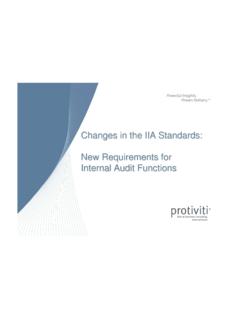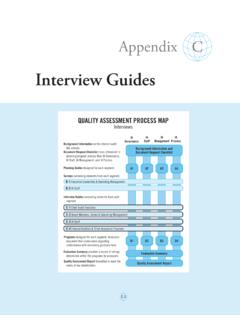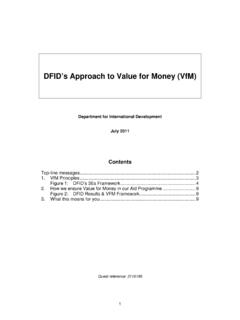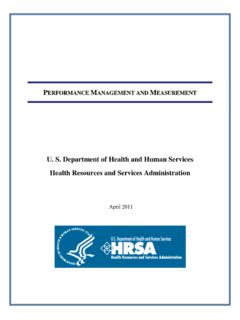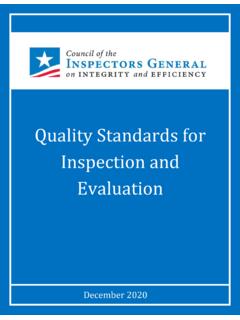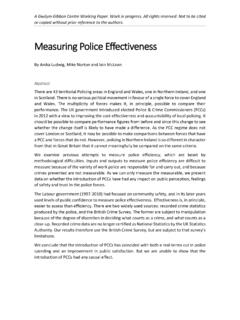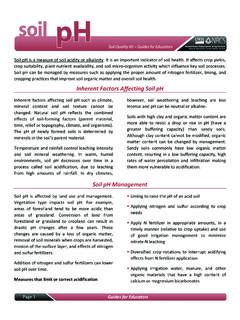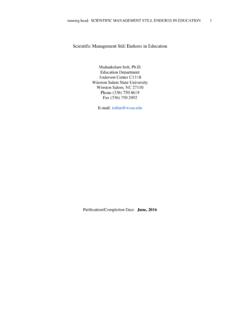Transcription of Measuring the Effectiveness of the Internal Audit Function
1 Measuring the Effectiveness of the Internal Audit FunctionPractical tools for Internal auditors2 IIA Nederland, Burgemeester Stramanweg 102A, 1101 AA Amsterdam, The NetherlandsIIA Professional Practices CommitteeFor more information: of Contents Foreword 4 Introduction 5 Section 1 Laws and regulations, requirements and rules 7 Professional requirements 7 Laws and regulations 7 Banks 8 Insurers 9 IA Ambition Model 9 Section 2 Effectiveness and efficiency 11 Section 3 Stakeholders 12 Section 4 Measurement toolkit 13 Points for attention when designing a measurement toolkit 13 Effectiveness indicators 14 Measurement methods 21 Appendix I BCBS principles for the Internal Audit Function at banks 23 Appendix II EIOPA guidelines on the Internal Audit Function at insurers 25 Appendix III Examples of dashboards 26 Appendix IV KPI s Group Audit 294 Foreword In 2013, the Dutch central bank (DNB) conducted a study into the Internal Audit Function (IAF)
2 At Dutch banks. At a certain point in the study, the following challenging question presented itself: When can an IAF be considered effective? In the meetings between the IIA Netherlands Board and DNB, both parties strug-gled with this question. It was then already clear that many factors needed to be considered to be able to answer this question. Around eighteen months ago, a number of Internal auditors from the financial sector launched a debate about this issue. In The Netherlands and internationally, an inventory was made of the available frameworks of standards, best practices and performance indicators. There were many discussions and debates to determi-ne to what extent certain elements could help to answer the above challenging question. We would therefore like to thank everyone who provided input based on their individual expertise to help deliver this result.
3 Given that many different people were part of this group at one time or another, I will not thank individuals personally. However, I make an exception for Dennis Webbers, as he showed a tireless commitment at times when the issue momentarily seemed too diffuse to reach a conclusion. When the going gets tough, the tough get going .Have we managed to answer the question when an IAF can be considered effective? I cannot give a definitive answer to that question, as it depends on many factors such as: in what sector do you work, how has your mission statement been worded, and how do you collaborate with the Executive Board, Supervisory Board and external auditor? That said, anyone who has read this paper can select a number of relevant indicators appropriate to their own practice to develop a mature performance measurement and the accompanying reporting.
4 And that is a huge plus!I hope you will enjoy reading this BendermacherChair of IIA Netherlands5 The requirements placed on the Internal Audit Function (IAF) by Internal and external stakeholders seem to be constantly increasing. As a result of the financial crisis, new laws and regulations have been introduced in the financial sector and supervisory bodies have tightened up and expanded their supervision. In ad-dition, increasing critical attention is paid in the public domain to the design and operating Effectiveness of companies governance and their reporting of non-financial information. As the IAF plays an important role in the governance framework, there has been a corresponding increase in the requirements placed on the IAF. Various stakeholders quite regularly publish interesting documents that introduce additional requirements regarding the quality of the IAF.
5 Recently, the Monitoring Committee for the Dutch Corporate Governance Code presented its proposals for revising this Code. These proposals envisage a prominent position for the IAF, which is considered com-plementary to the external auditor. According to the Monitoring Committee: It is important to have a good interplay between the Executive Board, the Supervisory Board and the Audit Committee, as well as a good communication with the Internal Audit Function and the external auditor. An important element in the propo-sals in relation to the Effectiveness of the IAF is also included in guidance , which states that the Audit Committee should supervise the relationship with - and compliance with the recommendations of and follow-up given to comments of - the Internal auditor and external auditor.
6 The quality of an IAF is primarily related to its Effectiveness . How effective is an IAF and how can you measure that? Measuring the Effectiveness of an IAF is not easy to do. Besides quantitative aspects, many qualitative aspects play a role. In addition, the various stakeholders have different, and to some extent conflicting, ex-pectations in terms of the role and duties of the IAF. Furthermore, the number of stakeholders and interested parties appears to be increasing, leading to a further increase in the scope, and hence the importance, of the work of the IAF. Lastly, another factor is whether the IAF is part of a financial institution, a company in the trade/industrial sector or a government body. Therefore, it is important to clearly position the Function , to define its role and to safeguard this role by docu-menting it in a clear charter, as set out in the IIA standards.
7 This charter must then be approved by the Audit Committee and the Supervisory Board1. The charter must contain a mission statement setting out the duties of the IAF. This statement provides important guidance on how to determine and measure the Effectiveness of the paper gives an overview of the requirements placed by stakeholders on the Effectiveness of the IAF. Based on these requirements, practical performance indicators are defined, which can be used by IAFs to report on (the Effectiveness of) their performance. This paper was made possible thanks to a consultation round with various parties, including: IIA Netherlands, Professional Practices Committee; Dutch Banking Association, Audit Working Group Insurers Association, Internal Audit Sounding Board GroupIn addition the above-mentioned parties, various individual auditors provided valuable input for this paper.
8 As financial institutions generally lead the way in terms of regulations and the supervisory landscape, this paper will first explore this landscape (addressed in more detail appendices I and II). It should be kept in mind that Introduction1 This paper assumes an entity with a two-tier Board structure comprising an Executive Board and a Supervisory Board, which is a standard governance structure in the Netherlands and Continental Europe in regulations are based on the IIA s International Professional Practices Framework (IPPF). Subsequently, in section 2, the concepts of Effectiveness and efficiency are discussed, and in section 3 the relevant stake-holders for the IAF are identified. Lastly, in section 4, we discuss the points for attention when designing a measurement toolkit and we present examples of performance indicators.
9 This paper does not envisage that every IAF reports on all these indicators; each IAF should makes its own choices leading to a manageable dashboard and/or performance report. Examples of dashboards are shown in appendix features and characteristics of an IAF are a given, but they are nonetheless subject to change due to the influence of external developments. Based on the current definition of Internal Auditing2 by the Institute of Internal Auditors (IIA), the Function has the following characteristics: 1. Independence;2. Objectivity;3. Provides added value to improve the organisation;4. Helps the organisation achieve its objectives;5. Works according to a systematic, disciplined approach;6. Evaluates and improves the Effectiveness of risk management, control and governance standard characteristics must be reconfirmed annually and where possible periodically measured and reported on.
10 By maintaining a dialogue with its stakeholders, the IAF can gain insight into the information needs. It can then design an appropriate measurement IIA has issued guidance to Audit Committees on how to assess the IAF s activities and performance, which includes the Practice Guide Measuring Internal Audit Effectiveness and efficiency published in De-cember 2010. This guidance is based on IIA s International Professional Practices Framework (IPPF) gover-ning the behaviour and professional practice of Internal Laws and regulationsThe raison d tre of the IAF at Dutch financial institutions is primarily based on its position under Dutch law, and more specifically the Decree on Prudential Rules relating to the Financial Supervision Act (implementing Section 3:17(2a) of this Act). Section 17(4) of the Decree sets outs the obligation to have an IAF as follows: The Effectiveness of the organisational design and of the procedures and measures will be independently assessed at least once a year.

